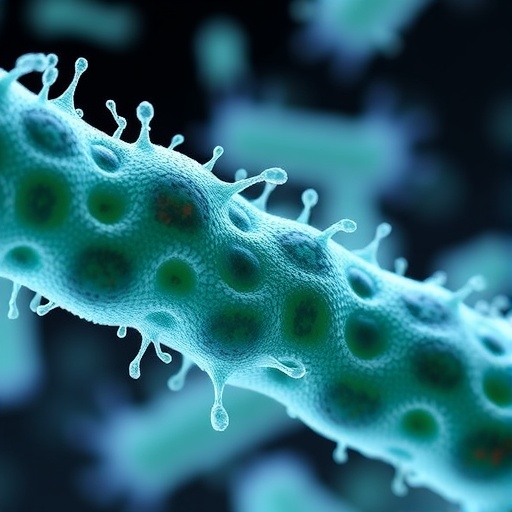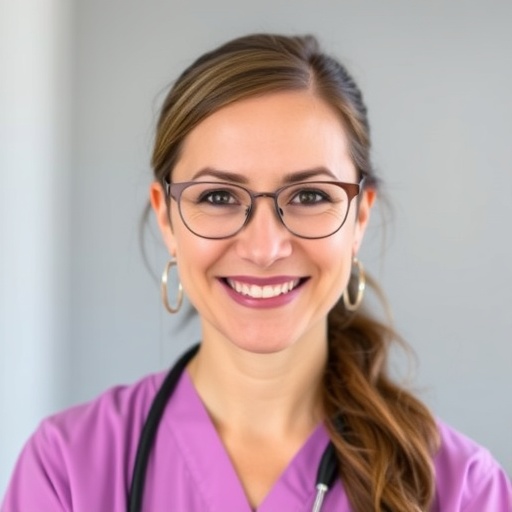Researchers at the University of California San Diego School of Medicine have unveiled a groundbreaking discovery about how the notorious pathogen Staphylococcus aureus, widely recognized as a principal agent of skin and soft tissue infections, actively hinders the wound healing process. This revelation centers on the bacterial communication system known as quorum sensing, a sophisticated mechanism that enables bacterial populations to synchronize their behavior in response to cell density. By deciphering the intricate role quorum sensing plays in chronic wound infections, the scientists have opened the door to innovative therapeutic avenues that circumvent traditional antibiotic use, potentially revolutionizing wound management.
The phenomenon of quorum sensing involves bacterial cells emitting and detecting chemical signaling molecules called autoinducers. When a critical concentration of these molecules is achieved, it triggers collective changes in gene expression that dramatically alter bacterial physiology and virulence. In the context of S. aureus infections, the quorum sensing machinery allows the bacteria to sense their population density within a wound environment, coordinating the expression of genes that suppress healing and reinforce the infection’s persistence. This molecular dialogue within bacterial communities influences not only their survival but also directly impacts host tissue repair mechanisms.
At the core of this bacterial communication system lies the accessory gene regulator, or agr, a quorum sensing circuit that operates as a molecular switch controlling the expression of virulence factors and other genes crucial for pathogenesis. The UC San Diego research team demonstrated that activation of the agr system in S. aureus during wound infection leads to a profound suppression of metabolic gene activity in keratinocytes—the skin cells responsible for reconstructing the protective epidermal barrier. This gene suppression effectively cripples the reparative capabilities of the skin, contributing to the chronicity and delayed closure of wounds infected by S. aureus.
The research incorporated both murine and human wound healing models, enabling a comprehensive examination of the agr system’s influence across species. Through these models, the investigators observed that interfering with or disabling agr signaling in S. aureus markedly restored normal wound healing kinetics and keratinocyte function, even when bacterial loads remained high. This was a pivotal finding that suggests it is possible to disarm this pathogen’s harmful effects without completely eradicating it—thereby reducing reliance on antibiotics and diminishing the selective pressure for antibiotic resistance development.
Further contrasting the pathological effects of S. aureus, the study evaluated the impact of a benign skin commensal, Staphylococcus hominis. Unlike S. aureus, exposure to S. hominis did not impede the wound healing process; instead, it enhanced beneficial metabolic functions in skin cells. This highlights the crucial role of the wound microbiome in modulating immune responses and tissue repair. Maintaining or restoring healthy microbial communities on the skin surface could be a promising strategy to bolster natural healing mechanisms and fend off opportunistic infections.
The clinical implications of these findings are vast, particularly in light of the increasing prevalence of methicillin-resistant Staphylococcus aureus (MRSA) strains, which pose significant treatment challenges worldwide. MRSA is notorious for causing severe healthcare-associated infections, including surgical site infections, bloodstream infections, and pneumonia. Identifying quorum sensing as a driver of impaired wound healing reframes therapeutic targets, shifting focus from killing bacteria outright toward modulating their behavior and virulence.
This paradigm shift in understanding S. aureus pathogenesis offers a dual advantage: it potentially reduces the incidence of antibiotic-resistant infections by minimizing antibiotic use and improves patient outcomes in chronic wounds that are otherwise difficult to treat. Current wound care strategies often fall short of addressing the microbial communication networks underpinning persistent infections. Targeting quorum sensing, specifically the agr system, could neutralize bacterial pathogenicity without hampering beneficial microbial populations.
Moreover, this study emphasizes the importance of the skin’s microbial ecosystem in overall health and disease, an area that has gained significant traction in recent years. Therapeutic approaches designed to restore microbial balance, possibly through probiotics or microbiome transplantation, might synergize effectively with quorum sensing inhibitors to promote more rapid and robust wound healing.
While this investigation provides critical mechanistic insights and proof-of-concept evidence in preclinical models, further research is necessary to translate these discoveries into clinical therapies. Rigorous clinical trials will be required to evaluate the safety, efficacy, and practical application of quorum sensing inhibitors or microbiome-modulating treatments in diverse patient populations, including those with diabetes, vascular disease, or immunocompromised states where wound healing is severely compromised.
The lead authors of the study, Michelle D. Bagood, Ph.D., a postdoctoral researcher, and Richard L. Gallo, M.D., Ph.D., professor and chair of the Department of Dermatology at UC San Diego School of Medicine, underscore the transformative potential of targeting bacterial communication pathways over traditional antibiotic regimens. Supported in part by grants from the National Institutes of Health, their work paves the way for a new generation of anti-virulence therapeutics that could mitigate the global burden of chronic and hospital-acquired wound infections.
This research was published in the Journal of Clinical Investigation, encapsulating an important advancement in infectious disease biology and wound care science. As antibiotic resistance continues to threaten global health, innovative strategies such as quorum sensing disruption offer hope for sustainable, effective treatments that not only combat infection but also facilitate the body’s natural healing processes.
In summary, this study reveals how Staphylococcus aureus commandeers the agr quorum sensing system to subvert skin repair by suppressing keratinocyte metabolism, and shows that disabling this communication restores healing without eliminating bacteria. Equally, it highlights the symbiotic role of non-pathogenic bacteria like Staphylococcus hominis in supporting skin health. This dual insight into pathogenic manipulation and microbial equilibrium heralds a paradigm shift in how chronic wound infections might be managed, emphasizing microbial behavior modulation rather than bactericidal interventions, a shift poised to influence clinical practice profoundly.
Subject of Research: Bacterial quorum sensing and its impact on wound healing in Staphylococcus aureus infections
Article Title: Targeting Quorum Sensing to Restore Wound Healing in Staphylococcus aureus Infections
Web References: https://doi.org/10.1172/JCI190411
References: The Journal of Clinical Investigation, University of California San Diego School of Medicine, National Institutes of Health
Keywords: Wound healing, Skin, Staphylococcus aureus, Quorum sensing, agr system, Keratinocytes, MRSA, Microbiome, Antibiotic resistance, Chronic wounds, Host-pathogen interactions
Tags: antibiotic alternatives in wound carebacterial communication mechanismsbacterial signaling moleculeschronic wound infectionsgene expression in infectionshost tissue repair challengesinnovative therapeutic strategiesmolecular dialogue in bacterial populationsquorum sensing in Staphylococcus aureusStaphylococcus aureus skin infectionswound healing inhibitionwound management advancements





